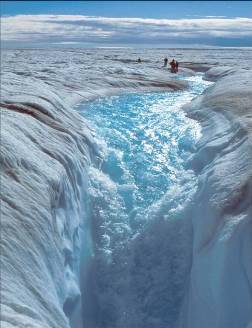
Waffle
“Flow will go faster if the bed becomes more slippery” says Alley. “Think of pancake batter spreading on a griddle – it goes faster if you grease the griddle, and if it’s on a smooth griddle than on a waffle iron.”
Observations from Greenland indicate that global warming could grease continental griddles in the future. They point to surface meltwater reaching the bed and lubricating ice motion near the edge of the Greenland ice sheet. While the increased speed from the additional water is not huge, it does appear real. In a warming world, this meltwater could also move inland to parts of the bed that are currently frozen and cause thawing, speeding the ice motion even further.
Another potential problem is that oceanic or atmospheric warming can thin and remove ice shelves – those flange-like edges of the ice sheet where the ice spreads and floats over the ocean waters, running aground on islands or scraping past the rocky sides of fjords. Such shelves provide a valuable restraint on ice flows due to the friction with the islands or fjord sides. Removing them can speed the process, raising sea levels.
“The processes responsible are not new but glaciologists were not aware of the existence of some, and their importance in influencing ice sheet dynamics” says Bamber. “The magnitude of the effect is far larger than we had expected and it is likely that these large fluctuations in ice dynamics have existed in the past but our observational capability has only recently provided us with hard evidence in the last decade or so.”
As oceans and the atmosphere warm, Bamber and his colleagues expect to see more examples of rapid and large changes in ice sheet volume. The race is now on to understand how quickly and to what degree these ice sheets may impact sea levels worldwide, as well as determining the relative influences of regional oceanic and atmospheric warming in the process.
“The real difficulties exist in a full understanding” says Alley. “There is a wealth of fascinating and important science to be done.”
Bamber agrees. “The observations provide a compelling picture of how the ice sheets are behaving” he says. “We need to better understand the physics underlying the mechanisms responsible and incorporate this into models so that we can better predict their future behaviour.”